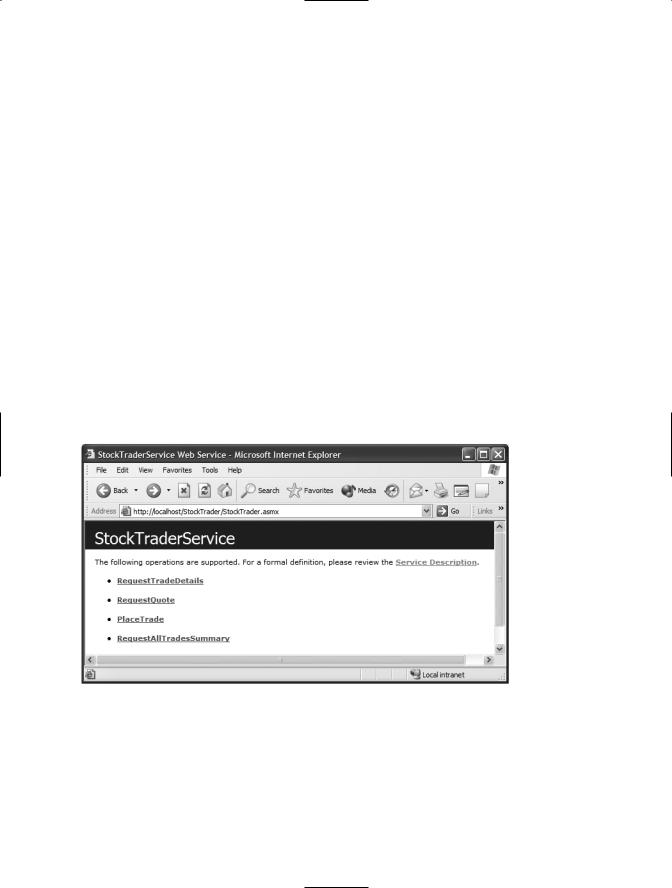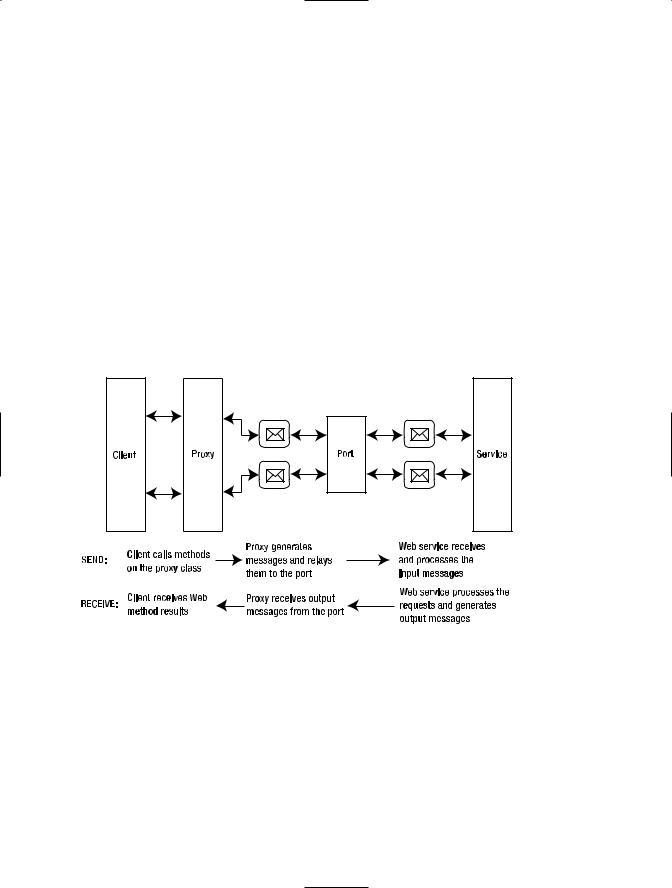
Expert Service-Oriented Architecture In CSharp 2005 (2006) [eng]
.pdf
26 C H A P T E R 2 ■ T H E W E B S E R V I C E S D E S C R I P T I O N L A N G U A G E
RequestTradeDetails" style="document" />
<input>
<soap:body use="literal" /> </input>
<output>
<soap:body use="literal" /> </output>
</operation>
<operation name="PlaceTrade">
<soap:operation soapAction="http://www.bluestonepartners.com/schemas/ /StockTrader/PlaceTrade" style="document" />
<input>
<soap:body use="literal" /> </input>
<output>
<soap:body use="literal" /> </output>
</operation>
<operation name="RequestQuote"> <soap:operation
soapAction="http://www.bluestonepartners.com/schemas/StockTrader/ RequestQuote" style="document" />
<input>
<soap:body use="literal" /> </input>
<output>
<soap:body use="literal" /> </output>
</operation>
</binding>
<service name="StockTraderService">
<port name="StockTraderServiceSoap" binding="tns:StockTraderServiceSoap"> <soap:address location="http:// www.bluestonepartners.com/StockTrader.asmx" />
</port>
</service>
</definitions>
This concludes the overview of the elements that make up a WSDL document. You can reference the complete WSDL document for this Web service in the sample code (available from the Source Code/Download section of the Apress web site at http://www.apress.com), under Chapter 2\WSDL Documents\. You may find the file easier to read if you open it in Visual Studio .NET or from within XML document editing software.
Working with WSDL Documents
Now that you understand the structure of a WSDL document, the next questions are how do you actually generate one, and what do you do with it once you have it generated? These are

C H A P T E R 2 ■ T H E W E B S E R V I C E S D E S C R I P T I O N L A N G U A G E |
27 |
not trivial questions, because the WSDL document is complex, and you will want to keep your manual alterations of the document to a minimum. Parsing errors are very easy to generate in a WSDL document from even the smallest of misapplied edits.
How to Generate a WSDL Document
The easiest way to generate a WSDL document is to use a tool such as Visual Studio .NET. There is very much a chicken-and-the-egg relationship between a WSDL document and the Web service implementation that it describes. That is, you can write the code first and generate the WSDL document later. Or you can manually write the WSDL document first, and then use it to autogenerate the code definition. Because it is very difficult to generate a WSDL document by hand, you are better off writing the code implementation first and then using Visual Studio .NET to generate the WSDL document for you.
Web services must be message-oriented if they are to be of any use in an SOA. Chapters 3 and 4 provide a detailed discussion of how to build message-oriented Web services. It is essential that you follow good design patterns and practices when building Web services for an SOA.
Assuming that you have built a message-oriented Web service according to the best patterns and practices (as discussed in the following chapters), you can generate a WSDL document by browsing the .asmx file of your Web service and clicking the Service Description link in the default client page. This link simply appends ?WSDL to the URL of the .asmx file. Figure 2-2 shows the default client page for the StockTraderService Web service and the corresponding Service Description link.
Figure 2-2. The default client page for the StockTraderService Web service
The Service Description link will display the WSDL document in a tree view–like format, wherein you can collapse and expand individual elements. This format is very useful for working your way through the document and learning how it is structured. Alternatively, you can copy the WSDL document from the browser window and then view it in an XML document editing application.

28 C H A P T E R 2 ■ T H E W E B S E R V I C E S D E S C R I P T I O N L A N G U A G E
What to Do with the WSDL Document
Once you have autogenerated the WSDL document, there are three main things that you will want to do with it. First, you will need to abstract out the data type information from the embedded <types> element into a separate XSD schema file. This is essential in an SOA so that other Web services and clients can have access to the same centralized schema definition file of the custom data types.
Second, you can use a command-line tool called wsdl.exe to autogenerate proxy classes that clients can use to interact with the Web service. You can replicate the same feature in Visual Studio .NET by adding a Web reference from a client project to a Web service.
Third, you can use the same utility with alternate switches to generate server-side code implementations of the Web service contract. You may either generate abstract classes, or you can generate service interface code methods that can be directly implemented rather than overridden. These code-generation capabilities are useful for creating a server-side “backend” implementation based on an established Web service contract. You will see examples of this in Chapters 3 and 4, where we use the utility to generate stub classes for the sample Web service implementation.
As you become a more sophisticated Web services developer, you will end up spending more time developing outside of the comfortable environment of Visual Studio .NET. This is because you will grow to need a higher level of control over your Web services development than Visual Studio .NET can currently provide.
Summary
In this chapter, you studied the structure of a WSDL document and found that it contains seven XML elements in addition to a root element called <definitions>. The seven additional elements are divided into two groups: one set provides an abstract description of the Web service, while the other set provides concrete implementation details that associate the abstract descriptions with the physical Web service.
The XML elements for abstract description are:
<types>: This element lists all of the data types that are exchanged by the XML messages as input parameters or return types.
<message>: This element describes a SOAP message, which may be an input, output, or fault message for a Web service operation.
<operation>: This element is analogous to a method definition; however, it only allows you to define input, output, and fault messages that are associated with the operation.
<portType>: This element lists all of the operations that a Web service supports.
The XML elements for concrete implementation are:
<binding>: This element links the abstract and concrete elements together within a WSDL document.
<port>: This element defines the URL where the Web service is located, and it also implements a <binding> element.
<service>: This element encloses one or more <port> elements.

C H A P T E R 2 ■ T H E W E B S E R V I C E S D E S C R I P T I O N L A N G U A G E |
29 |
This chapter concluded with a brief look at how to generate and work with WSDL documents. In the following two chapters, we will give you a detailed look at how to build message-oriented Web services and how to work with WSDL documents and XSD schema definition files.


C H A P T E R 3
Design Patterns for Building Message-Oriented
Web Services
In an SOA, the purpose of Web services is to exchange and process XML messages, not simply to act as hosts for remote procedure call (RPC) style methods. The difference is that messages are bound to rich and complex operations, whereas RPC-style methods simply return a discrete result that is directly correlated to a specific set of input parameters. For example, a message-oriented Web method will accept a stock ticker symbol and return a detailed stock quote in response. In contrast, an RPC-style Web method will return a simple output value.
Unfortunately, development tools such as Visual Studio place a method-centric focus on Web services that causes you to lose sight of the bigger design picture and to take the underlying infrastructure for granted. It is very easy to build a Web service by creating an .asmx file and then throwing together several loosely related RPC-style Web method implementations. However, this is the wrong design approach because such a Web service fails to provide an integrated set of message endpoints. In simpler terms, the Web service fails to provide a service. The right design approach is always to think in terms of operations and XML messages and to consider how the Web service methods work together to provide a service.
This chapter begins with a challenge for you to set aside what you have learned about Web services development until now and to open your mind to a different design approach— one that is based on integrated XML messages, not on RPC-style methods.
How to Build a Message-Oriented Web Service
There are six steps involved in building a message-oriented Web service, which is simply a Web service that exchanges XML schema–based input and output messages rather than simple parameter-oriented values. The steps are described in the following sections.
Step 1: Design the Messages and the Data Types
Conceptually design what the messages and data types will look like. UML class diagrams are the best way to capture this information, and there is the added benefit that many of today’s UML tools support XML schema generation directly from UML class diagrams.
31

32 C H A P T E R 3 ■ D E S I G N PAT T E R N S F O R B U I L D I N G M E S S A G E - O R I E N T E D W E B S E R V I C E S
Step 2: Build the XSD Schema File for the Data Types
Use an XML designer tool to build the XSD schema file for all of the data types that are exchanged by the Web service methods. Visual Studio 2005’s XML Designer is a good tool, but you can use any XML designer tool that you are comfortable working with.
Step 3: Create a Class File of Interface Definitions for the Messages and Data Types
The interface definition class (IDC) file provides the abstract definitions of the Web service methods and its data types. This class file derives from the System.Web.Services.WebService class, so it can be readily implemented in a Web services code-behind file. The .NET Framework provides a command-line tool called xsd.exe for generating an IDC file based on an XSD schema file. This will manually generate class definitions for the data types. You can add this class file to your Web service project and then manually insert abstract definitions for the Web methods.
Optional Step 3A: Generate the WSDL Document Manually
If you are brave enough, you can generate the WSDL document manually once you have built the XSD schema file. However, the only real benefit you gain from this step is that you are then able to fully generate the IDC file using the wsdl.exe command-line tool. It is easier to follow step 3 (explained previously), using xsd.exe combined with manual coding of the abstract method definitions. The syntax of WSDL documents is very difficult to build correctly by hand. (Chapter 2 of this book, which reviews the structure of WSDL documents, is essential reading, so that you can understand how the WSDL document is structured and how it relays Web service metadata to Web service clients.)
Step 4: Implement the Interface in the Web Service
Code-Behind File
Your hard work in steps 1 through 3 pays off, and you are now ready to implement code for the Web methods. The Web service .asmx code-behind class derives from the System.Web.Services.WebService class by default, as does the IDC file from step 3, so you
can derive the .asmx code-behind class directly from the interface definition class instead of directly from System.Web.Services.WebService. You can then implement code for each of the methods.
Step 5: Generate a Proxy Class File for Clients Based on the WSDL Document
Web services have no reason to exist unless they are being used by clients. In this step, you generate a proxy class file based on the Web service WSDL document so that clients know how to call your Web service, and know what messages and data types will be exchanged. The wsdl.exe command-line tool will automatically generate this proxy class for you based on the WSDL document. And Visual Studio 2005 will automatically generate the WSDL document for you, so no manual work is required.

C H A P T E R 3 ■ D E S I G N PAT T E R N S F O R B U I L D I N G M E S S A G E - O R I E N T E D W E B S E R V I C E S |
33 |
You can actually skip this step if you are developing with Visual Studio 2005, because it will dynamically generate the proxy class file for you when you add a Web reference (for your Web service) to a client project. However, we prefer to manually generate the proxy class file so that we can either alter it or have it ready for clients who are using a development tool without code-generating wizards.
Step 6: Implement a Web Service Client Using a Proxy Class File
This final step hooks a client to your Web service. If you are using Visual Studio 2005, simply add a (dynamic) Web reference to the Web service in your client project, and this will automatically generate the proxy class file for you. This wizard will also make the necessary adjustments to your application configuration file to record the location of the Web service. Alternatively, you can manually add the proxy class file from step 5 to your project, update the configuration file, and begin coding. The client essentially does nothing more than delegate method calls to the Web service. Valid clients include Web applications, Windows Forms applications, console applications, or even other Web services.
Next Steps
This process is obviously more involved than simply creating a new .asmx file and immediately implementing code. But it is the right way to do things because it abstracts out the Web service definitions and the code implementations. Visual Studio and the .NET Framework provide all of the tools that you need to autogenerate the XML-based files and the code, so the amount of manual work is kept to a minimum.
The rest of this chapter dissects the various moving parts that make up a messageoriented Web service. You will gain a precise understanding of how multiple files and tools work together to define and implement a message-oriented Web service. We will also provide selective implementation examples that collectively show you how to build this type of Web service from scratch.
WHAT ARE DESIGN PATTERNS?
Design patterns are loosely described as time-tested, established solutions to recurring design problems. Formal design patterns are highly structured and follow strict templates. The design patterns that are presented in this book do not follow this rigorous format, but they are in keeping with the spirit of design patterns because they factor in industry-accepted practices for approaching recurring design problems.

34 C H A P T E R 3 ■ D E S I G N PAT T E R N S F O R B U I L D I N G M E S S A G E - O R I E N T E D W E B S E R V I C E S
Design and Build a Message-Oriented Web Service
This section provides the information that you need in order to build a message-oriented Web service. It is organized along the same six steps presented earlier and provides both conceptual information and implementation information.
The Role of XML Messages and XSD Schemas
The starting point in designing a Web service is to determine what XML messages it will exchange—specifically, what messages it will respond to, and what messages it will return. Figure 3-1 shows the standard architecture for a client that interacts with a Web service via a proxy class. This architecture is based on the principle that the client and the Web service both have a common understanding of the messages and data types that are exchanged between them. This understanding can only be achieved if the Web service publishes a clear document of the operations that it supports, the messages it exchanges, and the types that it uses. This document is the WSDL document (described in Chapter 2). The WSDL document is the main reference for describing a Web service, and it includes embedded type definitions and message definitions, among other things.
Figure 3-1. Web services architecture showing communication between the client and service
Consider the example Web service, StockTrader, from Chapter 2 that provides methods for retrieving stock quotes and placing trades. Listing 3-1 presents one of the Web methods called RequestQuote that accepts a stock ticker symbol and returns a detailed stock quote.

C H A P T E R 3 ■ D E S I G N PAT T E R N S F O R B U I L D I N G M E S S A G E - O R I E N T E D W E B S E R V I C E S |
35 |
Listing 3-1. Pseudocode for the RequestQuote Web Method
[WebMethod]
public Quote RequestQuote(string Symbol)
{
// implementation code
}
public class Quote
{
public string Symbol; public string Company; public string DateTime; public System.Double High; public System.Double Low; public System.Double Open; public System.Double Last; public System.Double Change;
public System.Double PercentChange; public System.Double Previous_Close; public string High_52_Week;
public string Low_52_Week;
}
This code listing represents a Quote type object and a method called RequestQuote that returns a Quote object. The RequestQuote method actually represents two messages: an input (or request) message that includes a stock ticker symbol; and an output (or response) message that provides a detailed stock quote. A client can only use the RequestQuote method if it can also understand the response. In other words, the client has to fully understand the definition of the Quote type in order to make use of the RequestQuote method. This is exactly the kind of information that WSDL documents and XSD schema files document.
Listing 3-2 shows what the RequestQuote input and output messages look like in WSDL.
Listing 3-2. WSDL for the RequestQuote Input and Output Messages, Including Associated Types
<wsdl:message name="RequestQuoteSoapIn">
<wsdl:part name="parameters" element="tns:RequestQuote" /> </wsdl:message>
<wsdl:message name="RequestQuoteSoapOut">
<wsdl:part name="parameters" element="tns:RequestQuoteResponse" /> </wsdl:message>
<wsdl:portType name="StockTraderSoap"> <wsdl:operation name="RequestQuote">
<wsdl:input message="tns:RequestQuoteSoapIn" /> <wsdl:output message="tns:RequestQuoteSoapOut" />
</wsdl:operation>
</wsdl:portType>
